Related Research Articles

A liquid-crystal display (LCD) is a flat-panel display or other electronically modulated optical device that uses the light-modulating properties of liquid crystals combined with polarizers. Liquid crystals do not emit light directly, instead using a backlight or reflector to produce images in color or monochrome. LCDs are available to display arbitrary images or fixed images with low information content, which can be displayed or hidden. For instance: preset words, digits, and seven-segment displays, as in a digital clock, are all good examples of devices with these displays. They use the same basic technology, except that arbitrary images are made from a matrix of small pixels, while other displays have larger elements. LCDs can either be normally on (positive) or off (negative), depending on the polarizer arrangement. For example, a character positive LCD with a backlight will have black lettering on a background that is the color of the backlight, and a character negative LCD will have a black background with the letters being of the same color as the backlight. Optical filters are added to white on blue LCDs to give them their characteristic appearance.

In electronics, a digital-to-analog converter is a system that converts a digital signal into an analog signal. An analog-to-digital converter (ADC) performs the reverse function.

Photonics is the physical science and application of light (photon) generation, detection, and manipulation through emission, transmission, modulation, signal processing, switching, amplification, and sensing. Though covering all light's technical applications over the whole spectrum, most photonic applications are in the range of visible and near-infrared light. The term photonics developed as an outgrowth of the first practical semiconductor light emitters invented in the early 1960s and optical fibers developed in the 1970s.

Digital Light Processing (DLP) is a set of chipsets based on optical micro-electro-mechanical technology that uses a digital micromirror device. It was originally developed in 1987 by Larry Hornbeck of Texas Instruments. While the DLP imaging device was invented by Texas Instruments, the first DLP-based projector was introduced by Digital Projection Ltd in 1997. Digital Projection and Texas Instruments were both awarded Emmy Awards in 1998 for the DLP projector technology. DLP is used in a variety of display applications from traditional static displays to interactive displays and also non-traditional embedded applications including medical, security, and industrial uses.

A mobile device is a computer small enough to hold and operate in the hand. Typically, any handheld computer device will have an LCD or OLED flat screen interface, providing a touchscreen interface with digital buttons and keyboard or physical buttons along with a physical keyboard. Many such devices can connect to the Internet and interconnect with other devices such as car entertainment systems or headsets via Wi-Fi, Bluetooth, cellular networks or near field communication (NFC). Integrated cameras, the ability to place and receive voice and video telephone calls, video games, and Global Positioning System (GPS) capabilities are common. Power is typically provided by a lithium-ion battery. Mobile devices may run mobile operating systems that allow third-party applications to be installed and run.
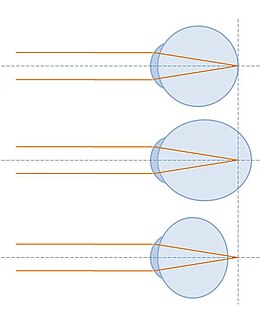
Refractive error, also known as refraction error, is a problem with focusing light accurately on the retina due to the shape of the eye and or cornea. The most common types of refractive error are near-sightedness, far-sightedness, astigmatism, and presbyopia. Near-sightedness results in far away objects being blurry, far-sightedness and presbyopia result in close objects being blurry, and astigmatism causes objects to appear stretched out or blurry. Other symptoms may include double vision, headaches, and eye strain.
A stereo display is a display device capable of conveying depth perception to the viewer by means of stereopsis for binocular vision.
A thin-film-transistor liquid-crystal display is a variant of a liquid-crystal display that uses thin-film-transistor technology to improve image qualities such as addressability and contrast. A TFT LCD is an active matrix LCD, in contrast to passive matrix LCDs or simple, direct-driven LCDs with a few segments.
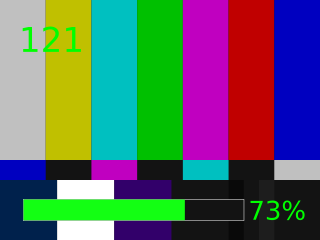
An on-screen display (OSD) is an image superimposed on a screen picture, commonly used by modern television sets, VCRs, and DVD players to display information such as volume, channel, and time.

A handheld projector is an image projector in a handheld device. It was developed as a computer display device for compact portable devices such as mobile phones, personal digital assistants, and digital cameras, which have sufficient storage capacity to handle presentation materials but are too small to accommodate a display screen that an audience can see easily. Handheld projectors involve miniaturized hardware, and software that can project digital images onto a nearby viewing surface.
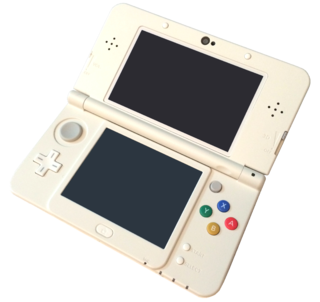
Autostereoscopy is any method of displaying stereoscopic images without the use of special headgear, glasses, something that affects vision, or anything for eyes on the part of the viewer. Because headgear is not required, it is also called "glasses-free 3D" or "glassesless 3D". There are two broad approaches currently used to accommodate motion parallax and wider viewing angles: eye-tracking, and multiple views so that the display does not need to sense where the viewer's eyes are located. Examples of autostereoscopic displays technology include lenticular lens, parallax barrier, volumetric display, holographic and light field displays.
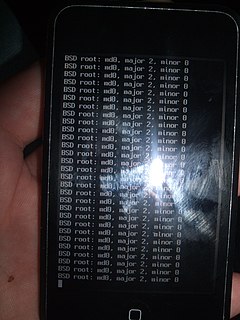
The word "brick", when used in reference to consumer electronics, describes an electronic device such as a mobile device, game console, or router that, due to corrupted firmware, a hardware problem, or other damage, can no longer function, and thus is "bricked". The device becomes as technologically useful as a brick, hence the name.
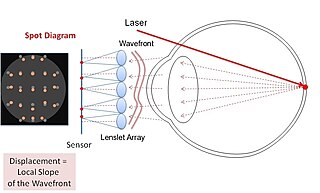
A Shack–Hartmannwavefront sensor (SHWFS) is an optical instrument used for characterizing an imaging system. It is a wavefront sensor commonly used in adaptive optics systems. It consists of an array of lenses of the same focal length. Each is focused onto a photon sensor. If the sensor is placed at the geometric focal plane of the lenslet, and is uniformly illuminated, then, the integrated gradient of the wavefront across the lenslet is proportional to the displacement of the centroid. Consequently, any phase aberration can be approximated by a set of discrete tilts. By sampling the wavefront with an array of lenslets, all of these local tilts can be measured and the whole wavefront reconstructed. Since only tilts are measured the Shack–Hartmann cannot detect discontinuous steps in the wavefront.

Retina Display is a brand name used by Apple for its series of IPS LCD and OLED displays that have a higher pixel density than traditional Apple displays. Apple has registered the term "Retina" as a trademark with regard to computers and mobile devices with the United States Patent and Trademark Office and Canadian Intellectual Property Office. The applications were approved in 2012 and 2014 respectively. The Canadian application cited a 2010 application in Jamaica.
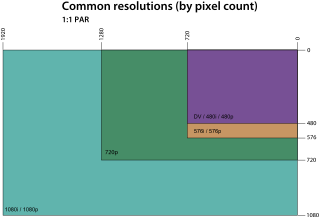
The graphics display resolution is the width and height dimension of an electronic visual display device, measured in pixels for electronic devices such as a computer monitor. Certain combinations of width and height are standardized and typically given a name and an initialism that is descriptive of its dimensions. A higher display resolution in a display of the same size means that displayed photo or video content appears sharper, and pixel art appears smaller.

Recon Instruments was a Canadian technology company that produced smartglasses and wearable displays marketed by the company as "heads-up displays" for sports. Recon's products delivered live activity metrics, GPS maps, and notifications directly to the user's eye. Recon's first heads-up display offering was released commercially in October 2010, roughly a year and a half before Google introduced Google Glass.
Universal Display Corporation is a developer and manufacturer of organic light emitting diodes (OLED) technologies and materials as well as provider of services to the display and lighting industries. It is also an OLED research company. Founded in 1994, the company currently owns or has exclusive, co-exclusive or sole license rights with respect to more than 3,000 issued and pending patents worldwide for the commercialization of phosphorescent based OLEDs and also flexible, transparent and stacked OLEDs - for both display and lighting applications. Its phosphorescent OLED technologies and materials are licensed and supplied to companies such as Samsung, LG, AU Optronics CMEL, Pioneer, Panasonic Idemitsu OLED lighting and Konica Minolta.

The Samsung Galaxy S series is a line of high-end Android mobile devices produced by Samsung Electronics. Together with the Samsung Galaxy Note and the Foldable Samsung Galaxy Z series, the lineup serves as Samsung's flagship smartphone model.
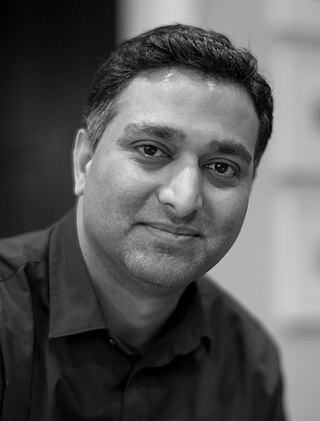
Ramesh Raskar is a Massachusetts Institute of Technology Associate Professor and head of the MIT Media Lab's Camera Culture research group. Previously he worked as a Senior Research Scientist at Mitsubishi Electric Research Laboratories (MERL) during 2002 to 2008. He holds over ninety patents in computer vision, computational health, sensors and imaging. He received the $500K Lemelson–MIT Prize in 2016. The prize money will be used for launching REDX.io, a group platform for co-innovation in Artificial Intelligence. He is well known for inventing EyeNetra, EyeCatra and EyeSelfie, Femto-photography and his TED talk for cameras to see around corners.

Kinsa Inc. is a health technology company headquartered in San Francisco, California, United States. Kinsa helps individuals and communities stop the spread of infectious illness by building a communication network that connects more than a million users with a free app, email alerts, and a connected thermometer.
References
- ↑ Pamplona, Vitor F.; Mohan, Ankit; Oliveira, Manuel M.; Raskar, Ramesh (2010). "NETRA: Interactive Display for Estimating Refractive Errors and Focal Range" (PDF). ACM Transactions on Graphics. 29 (4). doi:10.1145/1778765.1778814. hdl: 1721.1/80392 . Archived from the original (PDF) on 2012-10-12.
- ↑ Fildes, Jonathan. "Smart vision for mobile phones in the developing world". BBC News. Retrieved 27 December 2011.
